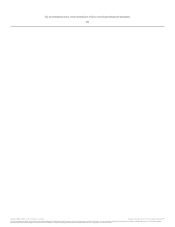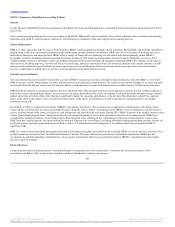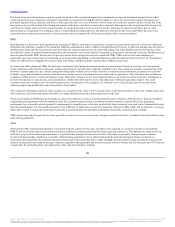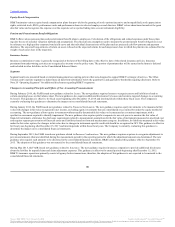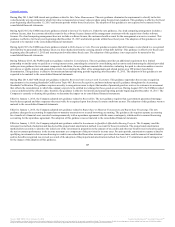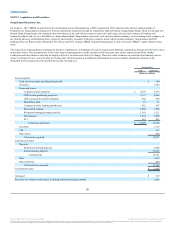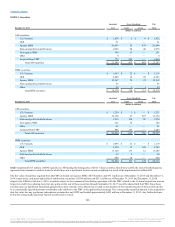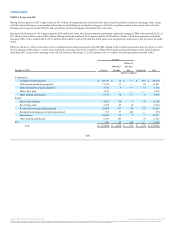BB&T 2015 Annual Report Download - page 105
Download and view the complete annual report
Please find page 105 of the 2015 BB&T annual report below. You can navigate through the pages in the report by either clicking on the pages listed below, or by using the keyword search tool below to find specific information within the annual report.
TableofContents
Premises and Equipment
Premises, equipment, capital leases and leasehold improvements are stated at cost less accumulated depreciation and amortization. Land is stated at cost. In
addition, purchased software and costs of computer software developed for internal use are capitalized provided certain criteria are met. Depreciation and
amortization are computed principally using the straight-line method over the estimated useful lives of the related assets. Leasehold improvements are
amortized on a straight-line basis over the lesser of the lease terms, including certain renewals that were deemed probable at lease inception, or the estimated
useful lives of the improvements. Capitalized leases are amortized using the same methods as premises and equipment over the estimated useful lives or lease
terms, whichever is less. Obligations under capital leases are amortized using the interest method to allocate payments between principal reduction and
interest expense. Rent expense and rental income on operating leases is recorded using the straight-line method over the appropriate lease terms.
Income Taxes
Deferred income taxes have been provided when different accounting methods have been used in determining income for income tax purposes and for
financial reporting purposes. Deferred tax assets and liabilities are recognized based on future tax consequences attributable to differences between the
financial statement carrying values of assets and liabilities and their tax bases. In the event of changes in the tax laws, deferred tax assets and liabilities are
adjusted in the period of the enactment of those changes, with the cumulative effects included in the current year’s income tax provision. Net deferred tax
liabilities are included in accounts payable and other liabilities in the Consolidated Balance Sheets.
Interest and penalties related to income taxes are recognized as a component of the provision for income taxes in the Consolidated Statements of Income.
Derivative Financial Instruments
A derivative is a financial instrument that derives its cash flows, and therefore its value, by reference to an underlying instrument, index or referenced interest
rate. These instruments include interest rate swaps, caps, floors, collars, financial forwards and futures contracts, swaptions, when-issued securities, foreign
exchange contracts and options written and purchased. BB&T uses derivatives primarily to manage economic risk related to securities, commercial loans,
MSRs and mortgage banking operations, long-term debt and other funding sources. BB&T also uses derivatives to facilitate transactions on behalf of its
clients. The fair value of derivatives in a gain or loss position is included in other assets or liabilities, respectively, on the Consolidated Balance Sheets. Cash
collateral posted for derivative instruments in a loss position is included in restricted cash on the Consolidated Balance Sheets.
BB&T classifies its derivative financial instruments as either (1) a hedge of an exposure to changes in the fair value of a recorded asset or liability (“fair value
hedge”), (2) a hedge of an exposure to changes in the cash flows of a recognized asset, liability or forecasted transaction (“cash flow hedge”), (3) a hedge of a
net investment in a subsidiary, or (4) derivatives not designated as hedges. Changes in the fair value of derivatives not designated as hedges are recognized in
current period earnings. BB&T has master netting agreements with the derivatives dealers with which it does business, but BB&T presents gross assets and
liabilities on the Consolidated Balance Sheets.
BB&T uses the long-haul method to assess hedge effectiveness. At inception and at least quarterly over the life of the hedge, BB&T documents its analysis of
actual and expected hedge effectiveness. This analysis includes techniques such as regression analysis and hypothetical derivatives to demonstrate that the
hedge has been, and is expected to be, highly effective in off-setting corresponding changes in the fair value or cash flows of the hedged item. For a
qualifying fair value hedge, changes in the value of the derivatives that have been highly effective as hedges are recognized in current period earnings along
with the corresponding changes in the fair value of the designated hedged item attributable to the risk being hedged. For a qualifying cash flow hedge,
changes in the fair value of the derivatives that have been highly effective are recognized in OCI until the related cash flows from the hedged item are
recognized in earnings.
For either fair value hedges or cash flow hedges, ineffectiveness may be recognized to the extent that changes in the value of the derivative instruments do
not perfectly offset changes in the value of the hedged items. If the hedge ceases to be highly effective, BB&T discontinues hedge accounting and recognizes
the interim changes in fair value in current period earnings. If a derivative that qualifies as a fair value or cash flow hedge is terminated or de-designated, the
realized or then unrealized gain or loss is recognized in income over the life of the hedged item (fair value hedge) or in the period in which the hedged item
affects earnings (cash flow hedge). Immediate recognition in earnings is required upon sale or extinguishment of the hedged item (fair value hedge) or if it is
probable that the hedged cash flows will not occur (cash flow hedge).
94
Source: BB&T CORP, 10-K, February 25, 2016 Powered by Morningstar® Document Research℠
The information contained herein may not be copied, adapted or distributed and is not warranted to be accurate, complete or timely. The user assumes all risks for any damages or losses arising from any use of this information,
except to the extent such damages or losses cannot be limited or excluded by applicable law. Past financial performance is no guarantee of future results.


